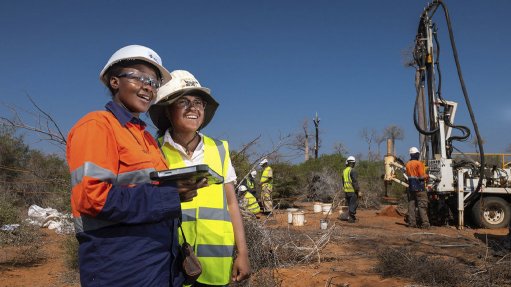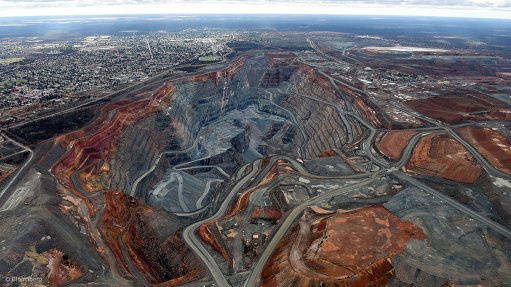Rainbow reports lower full-year output, but progresses strategy
London-listed Rainbow Rare Earths experienced operational challenges at its Gakara mine, in Burundi, and produced only 114 t of concentrate in the six months ended December 31, 2019.
This compares with the 564 t produced in the six months ended December 31, 2018.
The company says the mine had experienced operational challenges since late 2018, which led to a revision to the operating strategy in the interim period under review.
The revised strategy is based on a much larger operation, targeting at least 20 000 t/y of concentrate for 20 years.
The company’s loss before interest, taxes, depreciation and amortisation for the reporting six months amounted to $2.3-million, compared with a loss of $1.4-milllion reported in the prior comparable six months.
In the six months under review, the company appointed George Bennett CEO and obtained ten mining claims in Zimbabwe.
REVISED STRATEGY
The company explains that the mining of ore since the start of Gakara’s operations early in 2017 had consisted of the extraction of almost pure vein materials using hand tools, with the removal of waste being undertaken using a small fleet of largely rented mining equipment.
Mining had started at the Gasagwe deposit, with the second pit, Murambi, beginning operations in December 2018.
Tonnages of ore mined declined from the advent of the rainy season in September 2018, despite two pits being operated in parallel, and highlighted the limitations of this initial approach.
Rainbow says that, in particular, the rented equipment struggled to perform in wet conditions, resulting in significant periods of downtime following each rain event.
In addition, the lack of geological information on the orebody meant that ore tonnages were unpredictable, with veins seen at surface pinching and swelling, or even proving discontinuous, as mining descended.
Following a review of operations in August and September last year, mining was suspended at Gasagwe to focus on Murambi, which was felt to be more prospective in the near term.
The methodology for extracting ore was also revised during the period. Instead of mining veins by hand, assisted by mechanical equipment for waste removal, a more traditional bulk mining approach to extracting ore was trialled, whereby zones of mineralisation were identified and mined by excavator, prior to being transported by truck to the plant for treatment.
As a result, the total ore tonnage mined in the reporting six months increased to 3 900 t, compared with 580 t in the six months to June 30, albeit at much lower grades - typically below 5%.
Additional focus was placed on catching up on waste removal. In total, 246 000 t of waste was removed to dumps in the six months under review, which is a substantial increase compared with the previous six months, during which just 80 000 t were removed.
Production at Gakara has focused on deposits consist of stockworks of narrow, high-grade veins. The veins themselves are almost pure bastnaesite/monazite, and require minimal treatment to upgrade to the 54% minimum grade of total rare earth oxide (TREO) required for export and sale.
However, the veins are variable in form and thickness, and as a result production has proven difficult to predict from one bench to the next, Rainbow states.
The company adds that, therefore, a key priority for near-term production is to explore methods to be able to identify vein formations below surface level, to allow a reliable mine plan to be formulated.
Conventional drilling has limited effectiveness for vein stockworks, but may be used in conjunction with other methods under consideration – such as ground-penetrating radar, channel boring, and surface trenching.
Production levels cannot be stated with certainty, however once a mine plan has been drawn up, based on reliable geological data, and using the new mining equipment, concentrate production is expected to increase to more than 100 t per month, which is expected to cover the production costs following recent cost saving measures.
“Achieving break-even profitability at production level represents a considerable downgrading of expectations from the existing production set-up, however reflects a realistic assessment of the productive capacities of current operations.
“In addition, continuing operations represents an important means of meeting the company's social obligations towards its current workforce and local community. The goal will be to maximise production, beyond these levels if possible, provided this does not impact the longer-term prospects of for the mine,” Rainbow notes.
LONG-TERM GOALS
The near-term production strategy seeks to satisfy the company's in-country social obligations, thus keeping the mining permit in good order, while eliminating production losses as soon as practicable.
However, the ultimate strategy of the company remains the design of a much larger operation, capable of producing in excess of 20 000 t/y of concentrate at 54% TREO for at least ten years, but ideally up to 20 years or more.
“The extent of mineralisation across the permit is clear from the number of separate occurrences of mineralisation already found at surface,” the company says, adding that there exists more than enough material to supply a processing facility sized at 20 000 t/y. However, the work needs to be undertaken to define the deposit, and a first Joint Ore Reserves Committee-compliant resource is expected to be announced in April.
This resource will be initially based on Kiyenzi - which is a breccia deposit, in which rare earth mineralisation has been dispersed more widely. This results in an orebody that is lower in grade, but much wider than the high-grade vein stockworks seen elsewhere.
Importantly, it is also therefore more amenable to diamond core drilling, as well as being simpler to mine, which is why it is expected to form the cornerstone of the larger mining strategy.
The resource estimate will be based on the analysis of drill cores that were taken during 2018 but not yet fully analysed. Thereafter, a further drilling campaign will be undertaken later in 2020, with an enlarged resource to be declared subsequently.
At the same time, Rainbow is undertaking mineralogical and metallurgical analysis on various ore deposits, to ascertain the most appropriate treatment methodology for the larger plant.
Comments
Press Office
Announcements
What's On
Subscribe to improve your user experience...
Option 1 (equivalent of R125 a month):
Receive a weekly copy of Creamer Media's Engineering News & Mining Weekly magazine
(print copy for those in South Africa and e-magazine for those outside of South Africa)
Receive daily email newsletters
Access to full search results
Access archive of magazine back copies
Access to Projects in Progress
Access to ONE Research Report of your choice in PDF format
Option 2 (equivalent of R375 a month):
All benefits from Option 1
PLUS
Access to Creamer Media's Research Channel Africa for ALL Research Reports, in PDF format, on various industrial and mining sectors
including Electricity; Water; Energy Transition; Hydrogen; Roads, Rail and Ports; Coal; Gold; Platinum; Battery Metals; etc.
Already a subscriber?
Forgotten your password?
Receive weekly copy of Creamer Media's Engineering News & Mining Weekly magazine (print copy for those in South Africa and e-magazine for those outside of South Africa)
➕
Recieve daily email newsletters
➕
Access to full search results
➕
Access archive of magazine back copies
➕
Access to Projects in Progress
➕
Access to ONE Research Report of your choice in PDF format
RESEARCH CHANNEL AFRICA
R4500 (equivalent of R375 a month)
SUBSCRIBEAll benefits from Option 1
➕
Access to Creamer Media's Research Channel Africa for ALL Research Reports on various industrial and mining sectors, in PDF format, including on:
Electricity
➕
Water
➕
Energy Transition
➕
Hydrogen
➕
Roads, Rail and Ports
➕
Coal
➕
Gold
➕
Platinum
➕
Battery Metals
➕
etc.
Receive all benefits from Option 1 or Option 2 delivered to numerous people at your company
➕
Multiple User names and Passwords for simultaneous log-ins
➕
Intranet integration access to all in your organisation


















